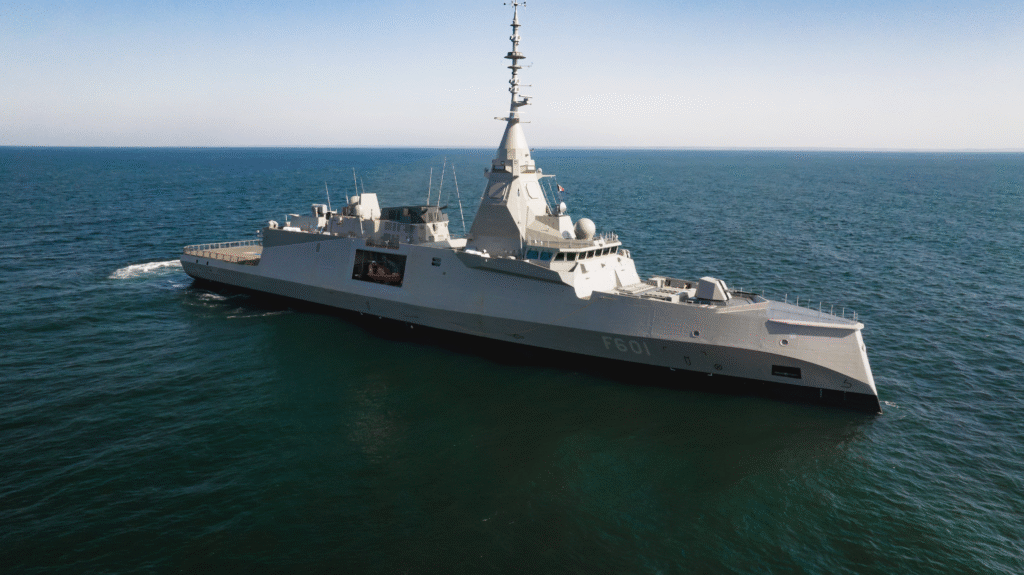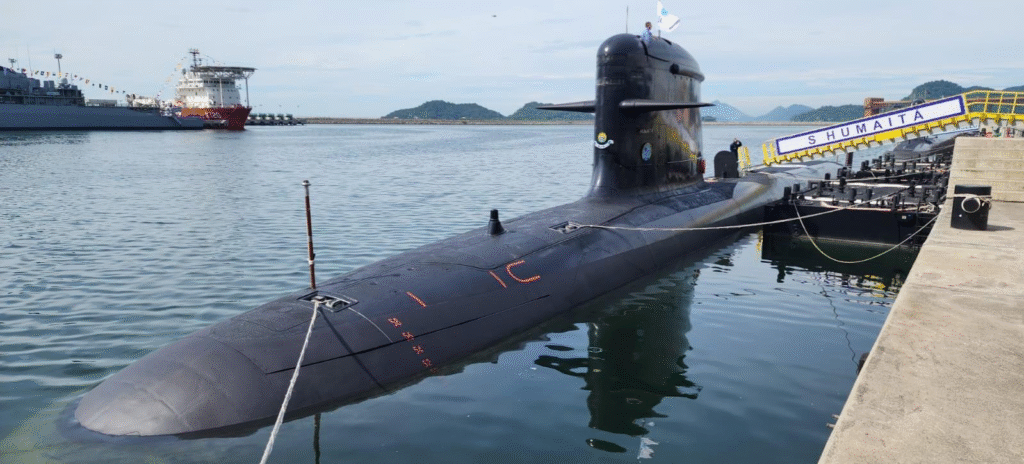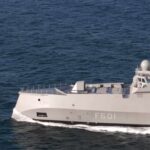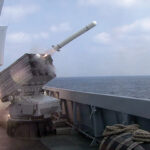An insight on the start of a critical milestone for the frigate Kimon and a brief by NG president mr.Pommellet during DEFEA 2025.
On the 21st of May, the first out of the three on order FDI frigates for the Hellenic Navy went underway to start her first round of sea trials. The frigate, that is officially christened HS Kimon and named after the Athenian general Kimon, son of Miltiades, was spotted leaving the shipyard facilities of Naval Group in Lorient during early morning hours after about one year and a half of fitting out.

The first round of sea trials, much like the schedule of Amiral Ronarc’h, will last for approximately three weeks and will include engine and electronic systems tests as long as combat management system tests. The engine tests already took place as, according to Marine Traffic data, the ship managed to reach and even exceed her required top speed on day one and has now returned back to base for the night.
At the same time, Naval Group, is preparing the third and final ship of the initial contract for launch on early June. HS Formion is currently inside the enclosed dry dock where it has been put together block by block, and once the ship hits the water, there will be three FDI frigates on the water on different stages of fitting out. Overall, the program seems to be running smoothly with a few months of delays that are to be expected for every major arms program and especially since the Lorient shipyards suffered from a reported sabotage about a year ago.
Some of the blocks that make up the frigate were constructed in Greece and specifically on the island of Salamis and the Salamis Shipyards and then shipped to Lorient for assembly. As representatives from NG stated, blocks made in Greece will also be utilized for the construction of the French frigates number two to five and a number of Greek defence companies are now part of the supply chain of NG. During a press meeting at the DEFEA 2025 with the president of NG, Mr. Pommellet, in which we had the privilege to attend, we learned that now seventy Greek companies participate in the program and are part of the company’s supply chain. This can effectively be translated into the following: any additional orders placed my France, Greece or any other third-party client, will in part, get carried out in Greece as well and not just France.

On the same manner, Mr. Pommellet stated that Naval Group has indeed submitted a new offer to the Greek government that aims to continue the modernization efforts of the government. As he said, Greece has expressed her ambitions to order up to seven new frigates that will be delivered by 2040 and will bring the number of modern surface units to ten, without counting any modernized ships or second-hand ones, at least this was the plan a few months ago as the Hellenic MoD, N.Dendias, had expressed the ambitions to acquire up to seven Constellation class frigates. But, with the Constellation dream getting sunk rapidly due to budget inflations, long term deliveries and design completion postpones it’s clear that this will be a hard to achieve dream if not outright impossible. So, the company has returned with an offer for three to four new frigates on top of the three under construction and the one under discussion. According to him, the company offers a boosted local industrial collaboration and hull construction and assembly on Greek shipyards. The best candidates are the Salamis shipyards and the Skaramanga Shipyards.

Likewise, he also spoke about the tender for four new submarines for the Hellenic navy. Much like previous clients of the company, India and Brazil, the company is willing to collaborate with local industries and supply chains and provide transfer of technology and knowhow that the country will find useful on the future. Both examples he brought up, Brazil and India, are now developing and constructing their own nuclear-powered submarines even though they had ordered the conventionally powered Scorpene sub. They now offer the same for Greece, meaning the Scorpene submarine with all the necessary updates made since the first vessel was commissioned in 2005, but they also doubled down with a conventionally powered Barracuda design. Ultimately, the choice falls upon the Greek government and of course, the available budget.

Back on the FDI program though, the president mentioned that thirty-five members of the Hellenic navy, officers and sailors, are already in Lorient and are receiving advanced training while many more are on different states of training in other facilities in Greece or Europe. Even though the Hellenic navy, much like any other western counterpart, is facing crew shortages with the ever-growing trend of leaves for the merchant navy, it seems like many are volunteering to go through training and serve on-board the newly constructed FDI frigates of the fleet. As it now seems, the arrival of new vessels can bring the much-needed spring to the fleet, perhaps this means that the salary is not the sole factor for a sailor.
Closing, it is noteworthy to mention that even though the bilateral agreement between Naval Group and the Hellenic State mentioned that the three frigates will be delivered in the, as mentioned, “Standard 1” configuration (also known as the French Version) and later get upgraded to the “Standard 2” mentioned on a Greek shipyard, it seems like the latter already happened. From photos and videos posted by Naval Group on their X account, one can clearly see that the additional two VLS systems are placed together with the RAM Close Weapons System on top of the hangar. This leaves us with one question: are those systems already integrated on the vessel or is additional work necessary upon delivery?





